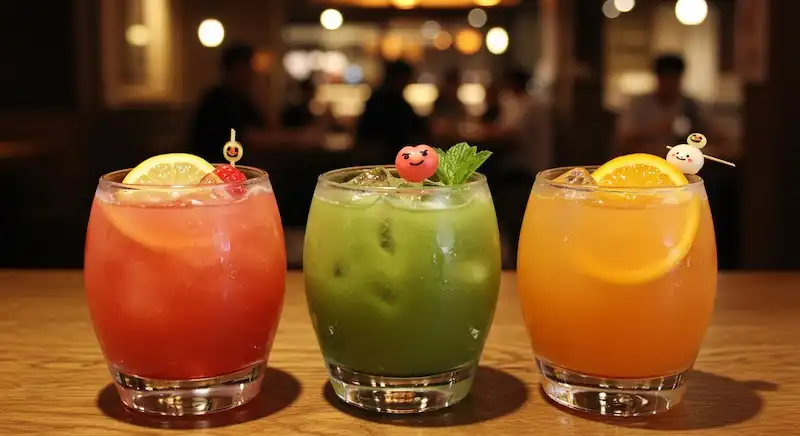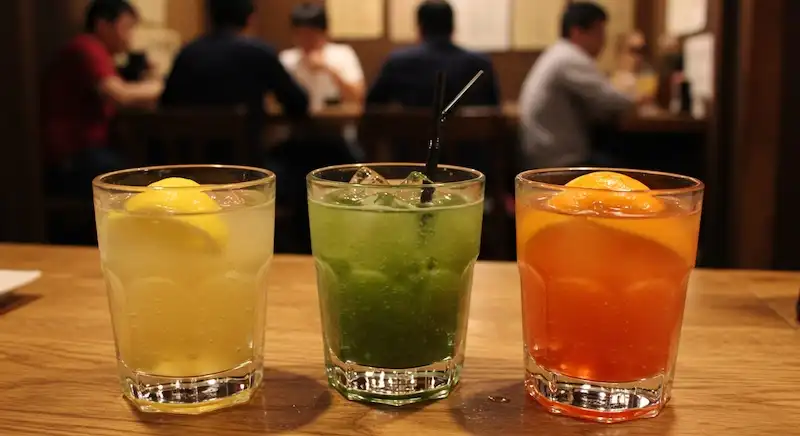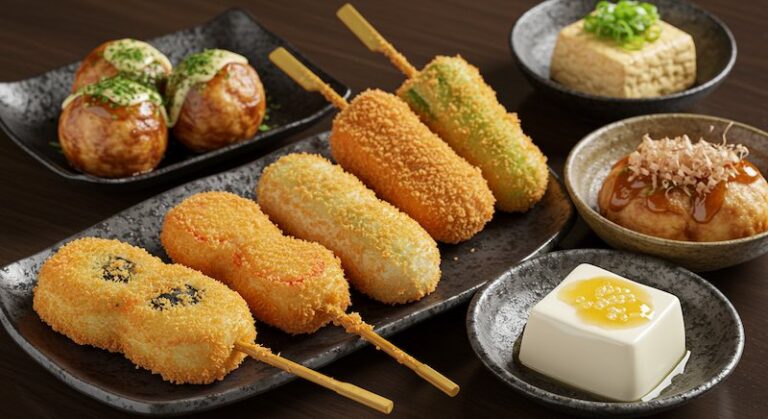The Allure of Sour Cocktails in Japanese Izakaya
Step into a Japanese izakaya, and you’ll likely see people of all ages, from business professionals to young adults, enjoying conversations with a sour cocktail in hand.
The refreshing taste seems to captivate everyone. But what exactly is a “sour” in the context of a Japanese izakaya? This article delves into its diverse appeal.
Table of Contents
An Izakaya Staple: What is a Japanese Sour?
The sour cocktail, or simply “sour” (sawa) as it’s often called, has become an indispensable part of the drink menu in Japanese izakaya and is immensely popular in Japan.
True to its English meaning of “tart” or “sour,” its defining characteristic is the refreshing acidity it delivers with every sip.
Generally, it’s made with a base spirit like shochu (a Japanese distilled spirit) or vodka, mixed with carbonated water and fruit juice.
Its easy-drinking nature and excellent compatibility with food have garnered support from a wide range of people.
Especially after work or during casual gatherings with friends, the sour is a go-to choice.
Compared to beer or sake, it offers a lighter and fruitier flavor profile, making it an appealing alternative for those seeking something different.
The ability to easily adjust the alcohol content is another reason for its widespread popularity.
- What is an izakaya? Find out here: Discovering Izakaya: Japan’s Unique and Welcoming Pub Culture
A Spectrum of Flavors: Types of Sours
Japanese izakaya offer an astonishing variety of sour flavors, starting with the classic lemon and grapefruit sours.
The list goes on to include apple, yuzu (a Japanese citrus fruit), plum, peach, and passion fruit, just to name a few.
Furthermore, shochu-based mixed drinks with tea, such as Oolong High (uron hai), Green Tea High (ryokucha hai), and Matcha High (matcha hai), are also widely recognized as types of sours.
This diverse range of flavors caters to a broad spectrum of palates, from those who prefer a less sweet drink to those who enjoy something almost dessert-like.
| Sour Type | Base Alcohol | Flavor | Key Characteristics |
| Lemon Sour | Shochu/Vodka | Lemon Juice/Slices | Refreshing, classic |
| Grapefruit Sour | Shochu | Grapefruit Juice/Slices | Slightly bitter, fruity |
| Plum Sour | Shochu | Plum Wine/Plum Syrup | Sweet and tart, Japanese style |
| Yuzu Sour | Shochu | Yuzu Juice/Slices | Aromatic, citrusy freshness |
| Apple Sour | Shochu | Apple Juice/Syrup | Sweet and tart, popular with women |
| Oolong High | Shochu | Oolong Tea | Refreshing, goes well with food |
| Green Tea High | Shochu | Green Tea | Mellow flavor, health-conscious |
| Shiso Sour | Shochu | Shiso (Japanese Basil) | Unique flavor, pairs well with oily food |
| Calpis Sour | Shochu | Calpis (Sweet Milk Drink) | Sweet and easy to drink, beginner-friendly |
| Tomato Sour | Shochu | Tomato Juice | Refreshing, health-conscious |
| Ginger Sour | Shochu | Ginger Syrup/Ginger | Spicy, warming |
Enjoying at Home: Popular Sour Recipes
The popular sours enjoyed in izakaya can easily be made at home.
Here are a few basic recipes for some representative types:
Classic Lemon Sour
Ingredients: 60ml shochu, 90ml carbonated water, 15ml lemon juice (or ½ lemon), ice
Instructions: Fill a glass with ice. Pour in the shochu and lemon juice.Slowly add the carbonated water and stir gently. Garnish with a lemon slice.
Frozen Lemon Sour
Ingredients: Shochu, carbonated water, frozen lemon slices or wedges
Instructions: Pour shochu into a glass and add frozen lemon instead of ice. Top with carbonated water.
Grapefruit Sour
Ingredients: 60ml shochu, 150ml carbonated water, juice of ½ grapefruit, ice
Instructions: Fill a glass with ice. Pour in the shochu and grapefruit juice. Slowly add the carbonated water and stir gently. Garnish with a grapefruit wedge.
Yuzu Honey Sour
Ingredients: 60ml shochu, 120ml carbonated water, 1 tablespoon yuzu honey, ice
Instructions: Fill a glass with ice. Pour in the shochu and yuzu honey. Top with carbonated water and stir well.
Oolong High
Ingredients: 30-45ml shochu, oolong tea (to fill), ice
Instructions: Fill a glass with ice. Pour in the shochu. Fill the glass with chilled oolong tea and stir gently.
Matcha High
Ingredients: 30-45ml shochu, matcha powder (to taste), green tea (to fill), ice
Instructions: Mix matcha powder into green tea and chill with ice. Fill a glass with ice. Pour in the shochu, fill the glass with the chilled matcha green tea, and stir gently.
- If you’d like to learn more about Bushido, please check out this article.
Many izakaya take pride in their unique recipes for classic sours like the lemon sour, and these recipes are often closely guarded secrets. However, understanding the basics allows you to enjoy delicious sours in the comfort of your own home.
Evolving with the Times: The History of Sours
The history of sours in Japan has roots in American cocktail culture.
However, the shochu-based sour is a uniquely Japanese creation that evolved in the country’s izakaya. After World War II, shochu became relatively affordable and readily available, which was a major factor in the spread of sours.
It’s said that the name “Lemon Sour” was first used in 1958 by “Ban,” a grilled offal (motsuyaki) restaurant founded in Nakameguro, Tokyo. Until then, a shochu highball (mixed with carbonated water) was called “Tan-chu,” but the founder of “Ban” coined the refreshing drink “Sour.”
The increased availability of fresh lemons at the time also contributed to the popularity of the Lemon Sour.
In 1980, Hakusui Sha launched “High Sour Lemon,” making it easy to enjoy lemon sours at home and further accelerating its popularity.
The 1980s also saw the nationwide expansion of izakaya chains, which began offering various chuhai (another name for shochu-based highballs), including lemon sours.
In 1984, Japan’s first canned chuhai, “Takara Can Chuhai,” appeared, firmly establishing the sour in Japan’s drinking culture.
Local Flavors, Seasonal Tastes: Regional and Seasonal Sours
Japan’s rich natural environment has given rise to unique regional sours and seasonal sours that utilize the freshest ingredients.
For example, apple sour is popular in Aomori Prefecture, while shikuwasa (a Okinawan citrus fruit) sour is beloved in Okinawa.
There are also craft chuhai made with local specialties like Sakurajima Komikan (a small tangerine from Kagoshima), Shonan Gold (a Kanagawa citrus fruit), and Mikabi Mikan (mandarin oranges from Shizuoka), each showcasing the distinct character of its region.
Seasonal sours also embody the essence of Japanese culinary culture.
Sours made with seasonal fruits like watermelon and peach in the summer, and yuzu and mandarin orange in the winter, offer a taste of the season.
Beverage manufacturers also release seasonal canned sours, such as Coca-Cola’s “Kigo no Lemon-do Harukoi White Peach and Lemon” (Spring-Loving White Peach and Lemon) and Sapporo Beer’s “Nippon no Shin Lemon Sour Natsu no Suzushi Lemon” (Japan’s New Lemon Sour Summer Refreshing Lemon) and “Fuyu no Fukami Lemon” (Winter Deep Lemon).
These regional and seasonal sours can be a special drink that evokes travel memories or the changing seasons.

Enhancing the Flavor: Tips for Enjoying Sours
To enjoy sours even more, here are a few key points. First, using fresh fruit juice and high-quality shochu or vodka is essential.
Also, choosing strong carbonated water will result in a more refreshing drink.
Chilling the glass beforehand is another secret to maintaining its deliciousness.
When making a lemon sour, squeezing the lemon with the peel facing down allows the aromatic oils from the skin to be extracted, enriching the flavor.
Sours pair wonderfully with classic izakaya dishes.
They can be enjoyed with fried foods like karaage (Japanese fried chicken) and yakitori (grilled chicken skewers), as well as edamame (boiled soybeans), salted cabbage, and grilled fish.
The acidity and carbonation of a lemon sour, in particular, act as a palate cleanser for richer dishes.
Continuing to Evolve: The Latest Sour Trends
The popularity of sours continues to evolve, with various new trends emerging.
One such trend is the rise of craft sours made with high-quality local ingredients.
Also gaining popularity are evolved versions of the lemon sour, offering a colder and richer taste using frozen lemon or shochu sherbet.
With increasing health consciousness, there’s also a growing demand for sugar-free and low-alcohol sours, as well as non-alcoholic versions.
Some unique flavors have even appeared, such as “Godzilla Sour” made with shikuwasa and chili peppers, and even a sour made with ponzu (citrus-based soy sauce).
Asahi Beer’s “Mirai no Lemon Sour” (Future Lemon Sour), which contains real lemon slices inside the can, is also attracting attention for its innovative approach.
It’s a Bit Confusing: The Difference Between Sour, Chuhai, and Highball
The terms sour, chuhai, and highball, often seen on izakaya menus, can be easily confused.
In Japanese izakaya, “sour” and “chuhai” are often used interchangeably.
Originally, chuhai referred to a shochu highball, meaning shochu mixed with carbonated water.
However, nowadays, it can also refer to drinks based on other spirits like vodka.
On the other hand, in Japan, a “highball” generally refers to whisky mixed with soda water.
| Drink Type | Base Alcohol | Common Mixer(s) | Key Characteristics |
| Sour | Shochu, Vodka, Other Spirits | Fruit Juice, Syrup, Soda Water | Refreshing, fruity, carbonated |
| Chuhai | Shochu, Sometimes Vodka | Soda Water, Fruit Juice, Tea, Other Beverages | Similar to Sour, originated as “Shochu Highball” |
| Highball | Primarily Whisky | Soda Water | Simple, refreshing, highlights whisky flavor |
The Appeal of Japanese Sours
The sour in Japanese izakaya, with its refreshing taste and diverse variations, is beloved by many.
From simple shochu and soda to those incorporating local specialties, seasonal ingredients, and the latest trends, its appeal is endless.
If you have the chance to visit a Japanese izakaya, be sure to try a sour.
It’s more than just a drink; it’s a glass filled with Japanese food culture, social interaction, and the flow of time.
Discovering your favorite flavor and enjoying it while chatting with friends is the true charm of the sour.













Leave a Reply